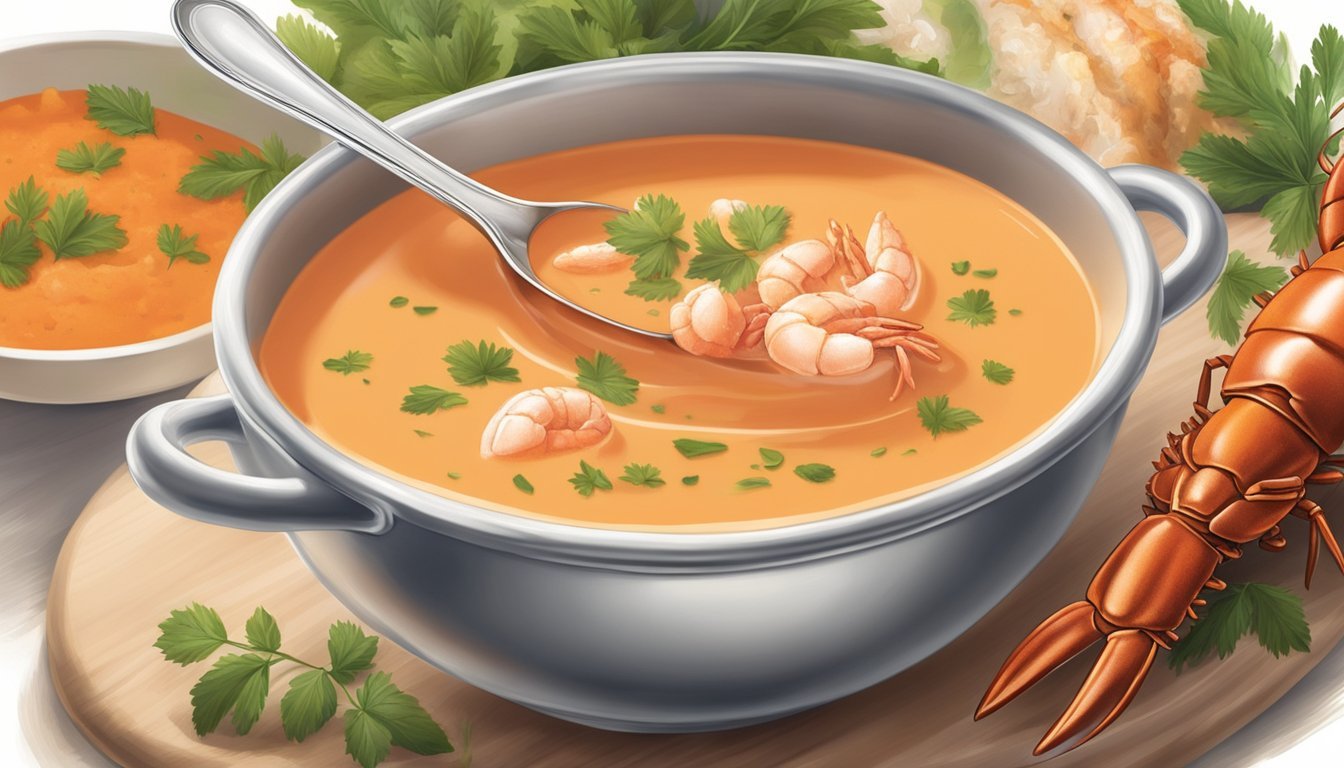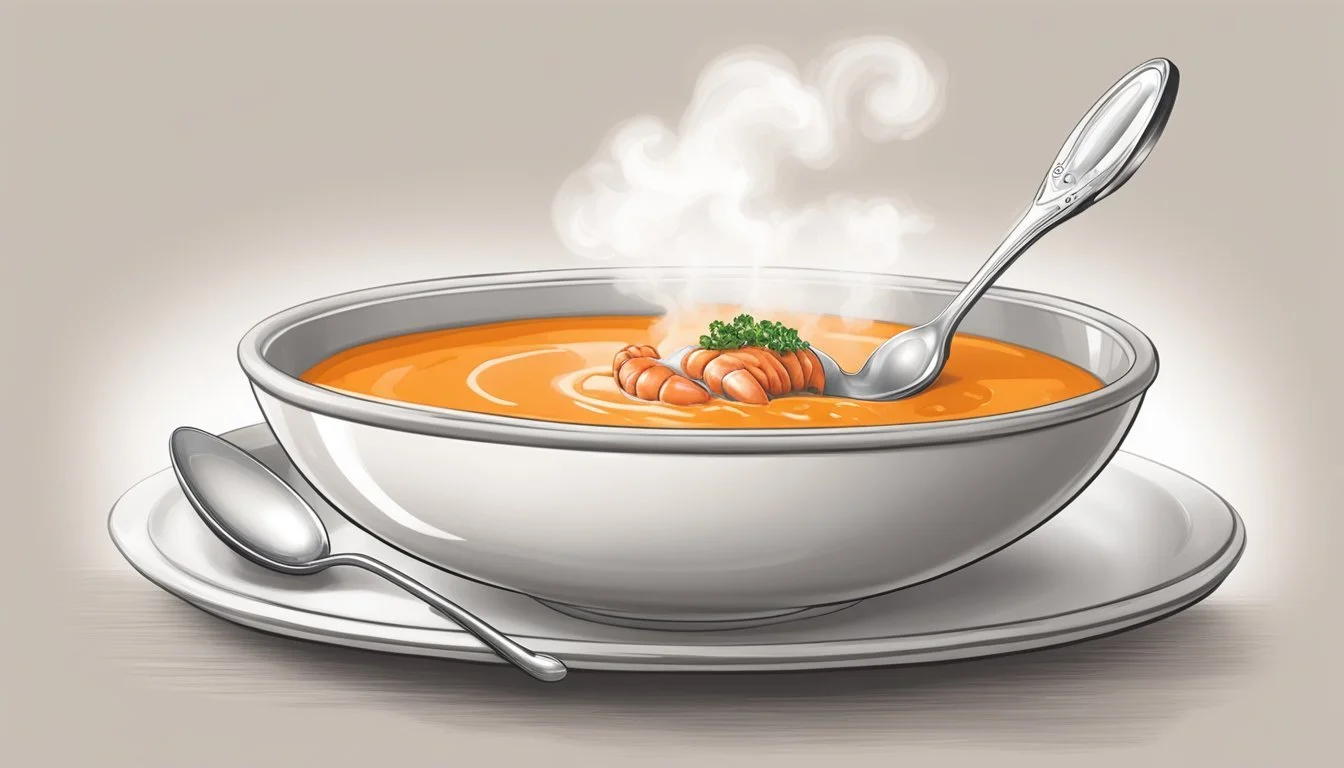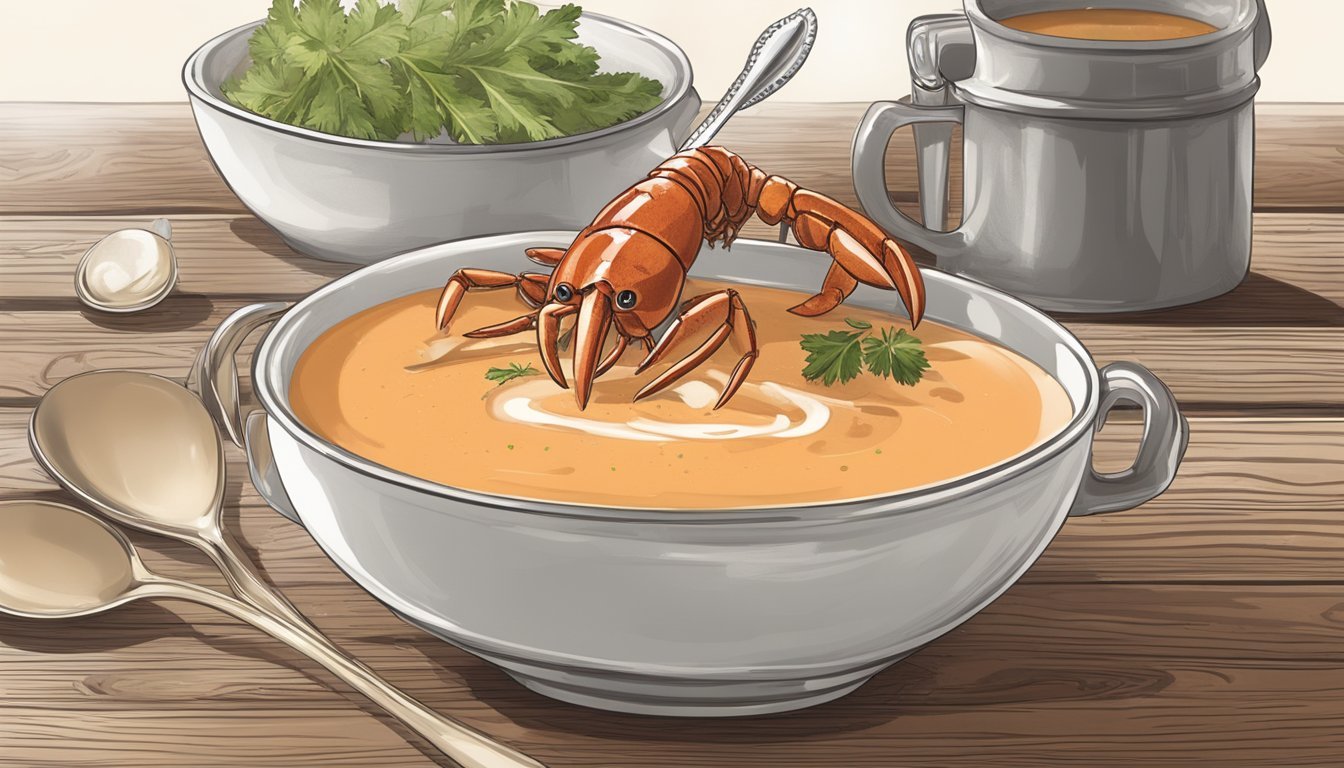How do you eat a lobster bisque?
Mastering the Art of Fine Dining
Lobster bisque is a rich and creamy soup traditionally savored as a starter in French cuisine, yet it has found its way to dinner tables worldwide due to its exquisite taste. The soup's base is a smooth and velvety concoction, often thickened with rice or a roux, into which the essence of lobster (What wine goes well with lobster?) is introduced. The process involves simmering lobster shells to extract their deep flavors, which are then strained out, leaving behind a soup imbued with the nuances of the sea.
To properly enjoy lobster bisque, it's typically served hot and is garnished with pieces of succulent lobster meat. The texture contrasts between the creamy soup and the firm lobster chunks are part of the experience. Some chefs may also add a splash of sherry or cognac, enhancing the bisque's flavor profile and adding a slight, sophisticated warmth.
The etiquette for eating lobster bisque involves relishing it slowly to appreciate the complexity of flavors derived from the careful blend of ingredients, including tomato paste, aromatics like thyme and bay leaf, and sometimes a touch of cream. Bread or croutons may accompany the bisque, providing an additional element to soak up every last drop of this cherished seafood (What wine goes well with seafood?) indulgence.
Understanding Bisque
Lobster bisque is a smooth, creamy, highly seasoned soup of French origin, classically based on a strained broth of crustaceans.
Bisque vs. Soup
Bisque is a specific type of soup that is distinguishable by its thick, creamy texture and the intense flavor of its main ingredient, often seafood. Traditional soups can range widely in terms of consistency and ingredients, but a bisque is typically made with shellfish (What wine goes well with shellfish?) and includes a smooth, pureed base. Ingredients are finely ground to create a uniform and velvety consistency, setting bisques apart from more broth-based and chunky soups (What wine goes well with soups?).
History of Bisque
The origins of bisque are tied to French cuisine with a focus on utilizing all parts of the ingredient. The classic lobster bisque, for example, extracts flavor from the entire lobster, including the shells, which are simmered to create a rich and flavorful stock. This method of cooking reflects the practical and waste-minimizing approach of historical French cooking practices. As seafood delicacies became more popular, bisque secured its place as a luxurious starter in fine dining.
Essential Ingredients
Preparing lobster bisque requires a delicate balance of ingredients to achieve the rich, smooth, and flavorful experience it's known for. Selecting quality components will shape the depth and authenticity of your bisque.
Lobster
The star of the show is the lobster, providing not only the key flavor but also the texture to the bisque. It's preferable to use fresh lobster tails, boiled until bright red and the meat is tender, ensuring that the essence of the lobster permeates through every spoonful.
Aromatics and Vegetables
Aromatics and vegetables such as onion, carrots, and celery (how long does celery last?) are fundamental, they're sautéed in butter to form a flavorful base known as mirepoix. Garlic adds more depth, while seasonings like salt and pepper are adjusted to taste.
Onion: Sauté until translucent.
Carrots: Provide sweetness; chop finely.
Celery: Adds aroma; ensure it's finely diced.
Garlic: Minced, to bring out its flavor without overpowering.
Liquids for Bisque
The liquids create the bisque's foundation, blending with the solid ingredients to result in a creamy soup. Seafood broth, heavy cream, white wine, and tomato paste are typically included, adding layers of flavor.
Seafood broth/Chicken broth: Forms the base of the bisque.
Heavy cream: For richness and creamy texture.
White wine: Adds acidity; use dry variants such as Chardonnay.
Tomato paste: For color and a hint of sweetness.
Thickening Agents
Lastly, thickening agents like rice, flour, or cornstarch are key for achieving bisque's characteristic richness and texture. They are used to avoid the soup becoming too thin.
Rice: A gluten-free thickener, it's simmered and then blended.
Flour: Combined with butter to make a roux for thickening.
Cornstarch: Often mixed with cold liquid before adding to avoid lumps.
Preparation Techniques
Creating a lobster bisque involves a series of steps that transform simple ingredients into a sophisticated and flavorful soup. The preparation techniques are crucial for extracting the maximum flavor from the lobster and developing a velvety texture in the finished bisque.
Cooking the Lobster
The lobster for the bisque should be cooked properly to ensure the meat is tender and easy to remove from the shell. Fresh lobster is typically steamed or boiled until the shell turns bright red and the meat becomes firm. After cooling, one extracts the lobster meat from the tail, claws, and knuckles, and reserves the lobster shells for making the stock.
Sautéing Aromatics
To build the foundation of the bisque's flavor, aromatics are sautéed in a mixture of butter and olive oil. This includes a variety of vegetables such as onions, carrots, and celery, along with diced garlic. Herbs like tarragon, thyme, or parsley can be added, along with a dash of tomato paste, to create a flavor base. For a bit of warmth, cayenne pepper or black pepper is often included.
Blending for Smoothness
Once the vegetables and aromatics have melded, blending is key to achieving the bisque's signature smooth consistency. An immersion blender works well to purée the mixture directly in the pot until smooth. If one prefers, the mixture can be transferred to a standalone blender in batches. It's important to blend thoroughly to avoid any chunks in the bisque.
Seasoning and Finishing Touches
The bisque is finished off by seasoning with sea salt, additional fresh herbs (how long do fresh herbs last?), and spices like thyme and cayenne to taste. To thicken lobster bisque and enhance its velvety texture, a roux made from flour and butter, or heavy cream is stirred in. The reserved lobster meat is then added back to heat through. The bisque is served garnished with a sprinkle of herbs or a dollop of cream, adding elegance to this rich and luxurious dish.
Serving Suggestions
Lobster bisque is a rich, creamy soup that epitomizes elegance on the dining table. Serving it properly enhances its luxurious nature and complements its delicate flavors.
Accompaniments
To heighten the experience of enjoying lobster bisque, a selection of accompaniments can round off the flavors. Crusty bread or sourdough bread serve as the perfect tools for savoring every last drop of this exquisite soup. They also add a desirable textural contrast to the smoothness of the bisque.
Presentation
The presentation of lobster bisque should echo its restaurant-quality appeal, whether serving for special occasions or a sophisticated family dinner. Employing warm bowls will keep the bisque at an optimal temperature. A light sprinkle of freshly chopped chives and a drizzle of sherry or brandy before serving add both color and depth to the dish. If opting for a splash of alcohol, ensure it is done sparingly to not overwhelm the delicate lobster flavor.
Sides and Pairings
While lobster bisque carries a presence all its own, accompanying side dishes can elevate the meal even further. Here is a concise list of pairings to consider:
Bread & Crackers:
Sourdough bread
Garlic Parmesan butter breadsticks
Vegetables:
Fresh seasonal vegetables, lightly steamed or sautéed in a skillet with a pinch of salt.
Salads:
A simple strawberry salad for a sweet and tangy contrast.
Cheese (how long does cheese last?):
Serve alongside a modest cheese platter – cheese's creaminess complements the bisque.
Proteins:
For other seafood enthusiasts, shrimp or crab (how long does crab last?)bisque can be served in smaller portions as a tasting pair with the lobster bisque.
Remember, each addition to the meal should be thoughtfully chosen to not overshadow the star: the lobster bisque soup itself.
Storage and Reheating
Proper storage and reheating methods are essential for maintaining the quality and flavor of lobster bisque. One should follow guidelines to ensure that this delicate soup remains a delightful offering.
Refrigerating Bisque
When refrigerating lobster bisque, cooling it to room temperature before placing it in the fridge is crucial to prevent bacterial growth. Store it in an airtight container to preserve its flavor and prevent it from absorbing other odors within the refrigerator. Bisque can be refrigerated for up to two to three days. When ready to reheat, transfer the bisque to a saucepan, warming it over low heat to retain its smooth texture; stirring occasionally to avoid scorching.
How to Freeze and Thaw
Lobster bisque can be frozen, which is especially useful if one has a large batch or wants to extend the shelf life of their leftover soup. To freeze lobster bisque:
Allow the bisque to cool completely.
Transfer to a heavy-duty freezer bag or an airtight freezer-safe container.
Label the container with the current date; bisque will retain quality for up to three months in the freezer.
To thaw frozen lobster bisque, one should plan ahead as the best method is a slow thaw in the refrigerator, which can take several hours or overnight. Once thawed, reheat the bisque over low heat, gently, to prevent separation of the cream base. It is not recommended to refreeze bisque once it has been thawed.
Health Benefits and Nutritional Information
Lobster bisque, a luxurious seafood soup, provides a mix of health benefits and rich flavors. The nutritional composition of lobster bisque can vary based on the recipe, but it typically includes beneficial nutrients derived from its primary ingredient, lobster, as well as from additional constituents like cream and butter.
Nutritional Breakdown
Lobster: The star ingredient of bisque, lobster is a significant source of protein, containing about 27 grams per 1-cup serving. It also boasts a wealth of vitamins and minerals, including vitamin B12, potassium, and calcium.
Protein: Essential for muscle repair and growth.
Omega-3 fatty acids: Prominent in seafood, known for heart health benefits.
Vitamin B12: Crucial for nerve function and energy production.
Calcium: Important for bone health.
Potassium: A mineral that aids in muscle function and fluid balance.
Other Ingredients: Bisque typically contains butter and cream, which add a creamy texture but also contribute saturated fats. These ingredients should be consumed in moderation.
Nutrient Amount Calories ~ per serving can vary Protein 7g per cup (from lobster) Fat Dependent on butter/cream content Carbohydrates Minimal in lobster, higher with flour addition Vitamin A 225μg per serving Calcium & Potassium Present in varying amounts
Dietary Considerations
When consuming lobster bisque, one should be mindful of portion sizes due to the potential high calorie and fat content from added ingredients like butter and cream. Although lobster itself is nutritious, the bisque can become indulgent when enriched with these additional components. It’s also important for individuals monitoring their sodium intake to be cautious, as soups often contain significant amounts of salt.
Moderation: The key to enjoying lobster bisque as part of a balanced diet.
Portion Control: Essential to prevent overconsumption of calories and fats.
Ingredient Substitution: One may opt for low-fat cream or milk alternatives to reduce fat intake.
By acknowledging the nutritional content and making informed dietary choices, consumers can include lobster bisque in their meals without compromising their health goals.
Recipes and Variations
Lobster bisque is a soup best known for its smooth, creamy texture and rich flavor profile, often served as a luxurious starter. The classic recipe typically involves a base made from lobster shells, heavy cream, and a blend of vegetables, while variations may include different seafood like shrimp or crab and additional ingredients like corn for a unique twist.
Classic Lobster Bisque Recipe
One can create a Classic Lobster Bisque by starting with the traditional preparation of cooking lobster tails and reserving the meat. The bisque is enhanced with a homemade stock, made by simmering the lobster shells with aromatic vegetables. Once the stock achieves its deep flavor, it is strained and then combined with a roux to thicken the soup, giving it a velvety consistency. The lobster meat is added back, and the soup is finished with a splash of wine and heavy cream. Seasoning variations might include a pinch of paprika or fresh herbs to bring out the lobster's sweetness.
Key Ingredients: Lobster, homemade stock, heavy cream, white wine
Seasonings: Paprika, salt, pepper
Preparation Time: Approximately 1.5-2 hours
Alternative Seafood Bisques
For those seeking variety, bisques present an excellent opportunity to incorporate alternative seafood options. A Shrimp Bisque features similar preparation methods but utilizes the shells of fresh shrimp to create a homemade stock, often paired with corn for a textural pop and a hint of sweetness. Alternatively, Crab Bisque can be prepared using crab meat and stock, with seasonal vegetables enhancing the flavor. While shrimp or crab can be interchanged with lobster, one should ensure that the seafood or fish stock used is of high quality to maintain the sophistication of the dish.
Shrimp Bisque: Shrimp stock, corn, heavy cream
Crab Bisque: Crab stock, crab meat, seasonal vegetables
Cooking Tip: Strain seafood stocks for a smooth base
Both adaptations lend themselves to experimentation with various seasonings and vegetables according to one's preferences, enabling a range of flavors while retaining the bisque's signature creamy consistency.
Tips for Cooking at Home
Cooking lobster bisque at home allows a chef to control the flavors and quality of the dish. Attention to ingredient selection and technique ensures a rich and decadent seafood experience.
Selecting Ingredients
Fresh lobster is the cornerstone of a superb bisque, influencing both taste and texture. For the most flavorful bisque, one should opt for live lobsters, ensuring the meat is as fresh as possible. The choice of butter is equally important; unsalted butter is preferred for its ability to let the natural flavors of the lobster shine. When it comes to cream, heavy or whipping cream contributes to the bisque's signature richness.
For the broth, homemade or high-quality store-bought seafood broth provides a depth of flavor that underscores the lobster's sweetness. A pinch of cayenne pepper can be added for a subtle heat that complements the salt and other seasonings. One should avoid overpowering the delicate lobster flavors with too much spice. Regardless of the chosen lobster bisque recipe, ensuring the use of high-quality, fresh ingredients is essential for a truly delicious main course.
Essential Ingredients Notes Fresh Lobster Foundation of the dish; ensures fresh taste and texture. Unsalted Butter For sautéing; allows for controlled seasoning. Heavy Cream Adds richness and body to the bisque. Seafood Broth Quality broth enhances the overall flavor profile. Cayenne Pepper Just a pinch required for a touch of heat.
Mastering the Technique
The chef should begin by cooking the lobster properly; boiling until the shells turn a bright red and the meat is tender, usually taking about 12 minutes for the initial pound and an additional 3 minutes per extra pound. They must ensure the lobster is plunged into the water headfirst and cooked with a tightly fitted lid.
In making the base, a classical approach involves first cooking the vegetables in unsalted butter until tender. After adding all-purpose flour to create a roux, one gradually incorporates the broth to build the foundational flavors. Blending a portion of the cooked lobster with some broth to achieve a smooth consistency is often the next step. To finish, the chef stirs in the cream, any additional lobster meat, and seasonings, and cooks over low heat until the bisque is thickened and flavors meld.
In summary, the key techniques are:
Precision Cooking: Ensuring the lobster meat is cooked just right.
Building a Flavor Base: Sautéing vegetables until tender, developing a roux, and carefully combining with broth.
Blending for Consistency: Processing part of the lobster with the broth for smoothness.
Gentle Simmering: Integrating the cream and lobster meat, simmering to the perfect consistency and flavor balance.
Consistency and patience are as crucial as the ingredients themselves, with each step layered to bring out the full array of flavors inherent in a classic lobster bisque.
Restaurants and Dining Out
When seeking out the finest lobster bisque, diners should prioritize restaurants with a reputation for high-quality seafood and a focus on freshness. The dining experience should pair the rich flavors of the bisque with complementary sides, enhancing the enjoyment of this celebrated dish.
Finding the Best Lobster Bisque
To savor an exceptional lobster bisque, it is essential to choose establishments known for their seafood expertise. Eddie V's Prime Seafood, for instance, is renowned for its lobster bisque that packs a flavorful punch. A customer's quest for the best bisque should include restaurants with culinary acclaim and a track record of sourcing premium ingredients.
What to Look for in a Restaurant-Quality Bisque
A top-notch lobster bisque at a reputable restaurant should exhibit a balance of flavor and texture. The bisque should boast a creamy consistency without being overly thick, with generous pieces of succulent lobster meat. A hint of sherry should be discernible, adding depth to the bisque's taste profile. High-quality bisque may also feature a delicately infused garlic essence, enriching the overall savoriness.
Additionally, for those special occasions, diners can look for luxurious variants that include not just lobster, but also complementary shellfish such as crab or shrimp, enhancing the gastronomic experience. It's worth noting that while lobster tails often provide the most meat, quality bisque utilizes all parts of the lobster to build a complex flavor.
The enjoyment of lobster bisque is further heightened when served with fresh, warm bread, perfect for sopping up the rich soup. Finally, attention to the dining atmosphere and service are crucial elements that contribute to a memorable lobster bisque experience at a restaurant.
Lobster Bisque FAQs
Lobster bisque is a rich and creamy soup known for its deep flavors and smooth texture. This section addresses frequently asked questions about selecting ingredients, preparation, and serving techniques for lobster bisque.
Common Questions Answered
What is the base of lobster bisque?
Lobster bisque is traditionally made with a base of lobster stock, often enhanced with white wine, such as Pinot Grigio, and heavy cream. A combination of fresh herbs, onions, and other aromatics are used to add depth to the flavor.
Can you use frozen lobster to make lobster bisque?
Yes, frozen lobster can be used for bisque, although fresh lobster tends to provide a richer taste. When using frozen lobster, ensure it is thoroughly defrosted before cooking. Fresh lobster meat is preferable if accessible.
What thickening agents are used in lobster bisque?
Rice is a common thickening agent in lobster bisque. It is pureed after being cooked with the soup, thus contributing to the bisque's characteristic creaminess without overpowering the lobster flavor.
How do you incorporate cream into lobster bisque?
Heavy cream is added to the bisque after the primary cooking and pureeing process. It should be warmed before mixing into the soup to prevent curdling and ensure a smooth integration into the bisque.
What type of stock should be used for lobster bisque?
Lobster stock, created from boiled lobster shells and aromatics, is ideal. However, seafood or fish stock, or even clam juice, can be used as substitutes or in combination with homemade lobster stock to intensify the seafood flavor.
How is lobster bisque typically served?
Lobster bisque is often served as a starter with a dollop of cream, a sprinkle of fresh herbs, or with lobster meat garnish. Some prefer to accompany it with a crusty bread or lobster rolls on the side.
Is there a preferred wine pairing for lobster bisque?
A crisp white wine such as a Chardonnay or the aforementioned Pinot Grigio complements the richness of lobster bisque quite well. They balance the creaminess with acidity and do not overwhelm the subtle lobster flavor.











